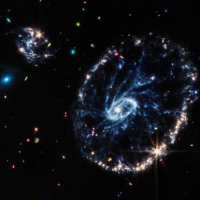G8JNJ
About
- Username
- G8JNJ
- Joined
- Visits
- 4,661
- Last Active
- Roles
- Member
- Points
- 130
Reactions
-
Linear power supply
It depends...
If the Apple charger is actually contributing noise in the first place, but it may not be.
There are so many potential noise sources, in, and around the home, that it may not be possible to observe any difference if you swap out the Apple supply, as its contribution may be masked by other stronger sources.
With noise, it's a bit like peeling an onion, as soon as you remove one layer of skin, there is another thinner layer underneath.
Personally, I'd attempt to identify other noise sources first, and try and deal with them, and work your way through the increasingly diminishing returns.
I use a TinySA Ultra with a telescopic antenna to "sniff" for noise sources around my property. But with care the KiWi can also be used for this purpose, by connecting a "sniffing" antenna via a long length of coax. Just be aware that when moving the antenna around, there is a short delay before received signals produce an output or appear on the waterfall.
Regards,
Martin
-
Any idea what this is?
-
VDSL filter for the Kiwi SNR measurement
I agree that the SNR measurement function is flawed, and appreciate that you, John, may have spent more time on it than you would like. However, even in its current form it is far better than having nothing at all.
This is especially true when using TDoA, as it allows you to see at a glance which KiWi's would definitely not be useable for such purposes, and this "pre sorting" saves a LOT of time and otherwise wasted effort.
Likewise, by providing SNR colour coded markers on the KiWi maps, it is easy to see which ones are likely to provide reasonable reception. As only about 10% of the 800+ KiWi's deployed worldwide produce relatively noise free performance. It would take a long time to find these among the vast majority of poorly performing ones, without some sort of SNR or other quality indicator being in place.
I'd also suggest that the SNR value, performs a useful function in encouraging KiWi owners to consider improving their antenna systems, and chasing down interference sources.
Overall, I think the SNR measurement has had a positive influence on the KiWi network, as a type of quality control, and that without it, there would be many more poorly performing KiWi's in operation.
Regards,
Martin
-
HT004a / LNA / Anyone used one?
Hi Glenn, I don't disagree, which is why I stated "Any further improvement can only be brought about by using a better antenna, or by reducing the amount of noise present by some other method."
If for example you have a problem with noise induced into the transmission line, amplifying and balancing at the antenna, then attenuating at the receiver, can reduce the noise contribution. This is only one example, but as you have said "sometimes, even if for the wrong reasons, a preamplifier might improve performance".
The point I was trying to make is that by just adding extra gain, it usually doesn't make things any better. It requires considered thought to do it correctly.
Regards,
Martin
-
HT004a / LNA / Anyone used one?
Before anyone gets their credit card (or other method of payment) out. Make sure you actually need a pre-amp.
In most cases, you will not, they are useful in specific situations, but unfortunately for the majority of KiWi owners, local noise and interference will be the limiting factor, and no amount of pre-amplification or filtering, can improve or remove, what is present, and intertwined with the desired signals.
One test, I suggest, is to make a note of your receiver noise floor with a screened 50 ohm load connected in place of your antenna. Then connect your antenna, and measure the noise floor again. Typically, do this on the HF bands, in a quiet chunk of spectrum, somewhere between 25 to 30MHz.
If the difference in noise floor readings is less than 6dB, you may benefit from using a better antenna, or in some cases a pre-amplifier.
If it is 6dB or more, then your system is already noise limited by your antenna and local environment, and this may be the best you can achieve. Any further improvement can only be brought about by using a better antenna, or by reducing the amount of noise present by some other method.
If the increase in noise is 10dB or more, then it is likely that you have a lot of noise and interference present, and this will be severely limiting reception. This may be because you are using a pre-amplifier ahead of your receiver, which is probably providing too much gain, and it will not further improve the sensitivity of your receiver, but it will be degrading the overall Dynamic Range, susceptibility to overload, and generation of spurious IMD products.
Unfortunately, because of the way that natural and galactic noise is distributed across the spectrum from 100kHz to 30MHz, the noise floor at 1MHz can be 20 to 30dB higher at 1MHz with respect to 30MHz. If you add a pre-amp to improve performance on the HF bands, the likelihood is that it will be providing excessive gain on the LF bands.
Many amateur band transceivers have different attenuator and pre-amplifier settings, that are automatically changed when a different frequency range is chosen. For example, on 1.8MHz a 10dB attenuator may be applied, whereas on 28MHz a 20dB pre-amplifier may be used.
When using a KiWi, which provides continuous coverage from 0 to 30MHz, we can't use this method. So the best alternative is to use a frequency / amplitude equaliser, or shelf filter, that provides a gradually rising amount of gain with frequency (actually an increasing amount of attenuation as the frequency decreases). By doing this, we can try to match the filter characteristic, with changes in the natural noise floor, so that we only provide as much gain as necessary at any given frequency.
In a practical installation, we also have to take into account the frequency response of the antenna, and it's gain characteristics. But this usually only requires a slight modification to the filter response.
This is a link to an old article entitled "Noise equalization in h.f. receiving systems" written by D. C. Bunday, a UK GCHQ engineer, way back in 1977. It explains the concepts very clearly, along with practical circuits. Although the notes refer to problems associated with Analogue receive systems, they are equally applicable to modern day SDR's and digital Short Wave receivers.
https://www.worldradiohistory.com/UK/British-Institution-of-Radio-Engineers/1977/TREE-1977-05.pdf
Regards,
Martin






